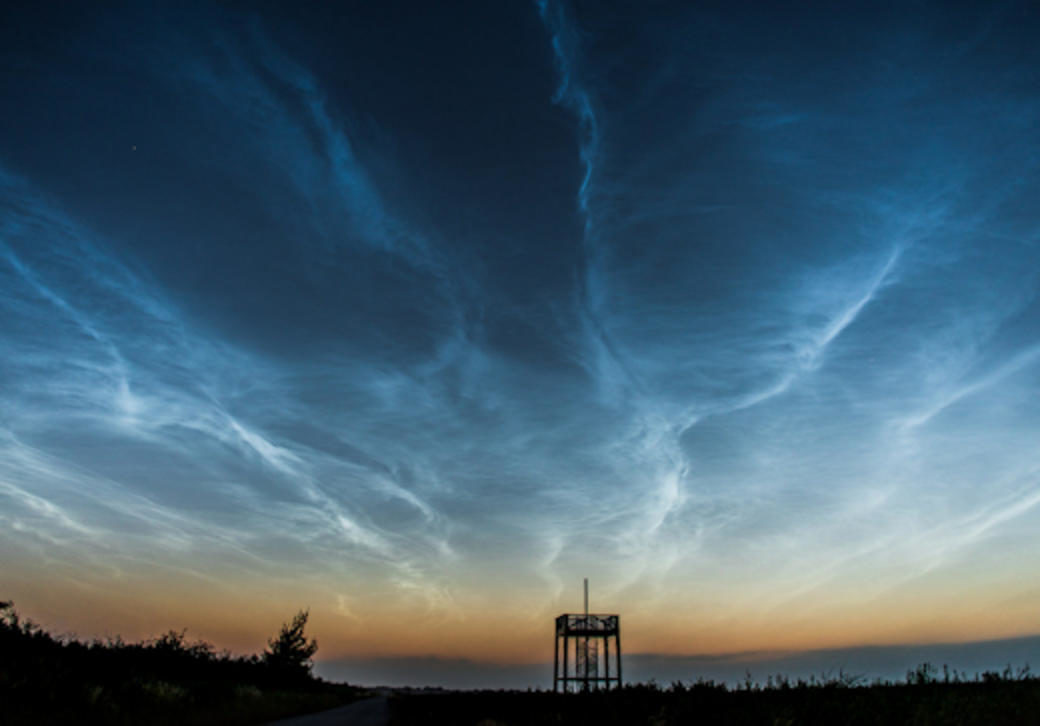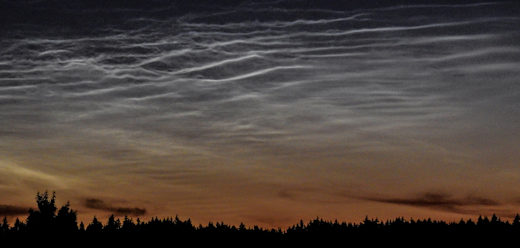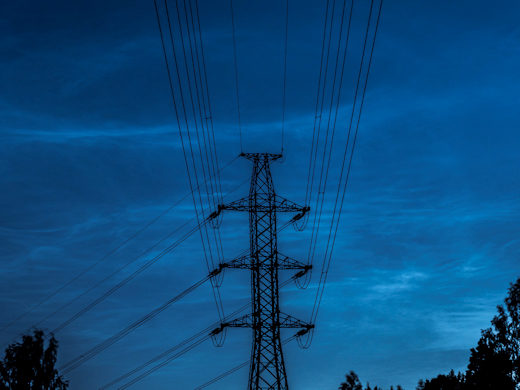"Last night, for the first time this summer, noctilucent clouds stretched across our whole sky," reports Danish observer Pernille Fjeldgaard Jensen. "Some of the clouds looked like silver corkscrews spiraling their long arms towards us.""It was a fantastic display," says Jensen, who took this picture from Denmark's Lille Vildmose Wild Life Park.
Noctilucent clouds (NLCs) form when summertime wisps of water vapor rise to the top of Earth's atmosphere and crystallize around specks of meteor smoke. Mesospheric winds gather the resulting ice crystals into clouds that float more than 80 km high. They can be seen long after sunset as they ripple and swirl across the night sky.
Observers in Europe have been seeing these clouds for more than a month. On July 4th, bright NLCs finally visited the continental USA. Dustin Guy saw the silvery forms spreading over Seattle:
"It was one of the most vivid noctilucent cloud displays I've seen in years," says Guy.
July is often the best month for NLCs with sightings in previous years as far south as Utah and Colorado. This week's display in Washington state means US observers may soon be able to join Europeans in their regular contributions to the NLC photo gallery.
Observing tips: Look west 30 to 60 minutes after sunset when the sun has dipped well below the horizon. If you see luminous blue-white tendrils spreading across the sky, you may have spotted a noctilucent cloud.
Observers of noctilucent clouds (NLCs) often describe their color as "electric blue." This high-voltage photo taken July 7th by Pentti Arpalahti of Helsinki, Finland, is a great example:
But why? What makes these clouds of frosted meteor smoke the color of an electric discharge? It turns out, electricity has nothing to do with it.
NLCs are blue for two reasons: (1) The clouds consist of tiny ice crystals about the size of particles in cigarette smoke. Cigarette smoke looks blue, too, and for the same reason. Tiny particles scatter blue light better than other colors. (2) Ozone! Research in the 1970s revealed that some of the sunlight hitting noctilucent clouds first passes through Earth's ozone layer. Ozone tends to scatter red light, while allowing blue to pass. Sunbeams hitting noctilucent clouds have thus been pre-conditioned for blue.






Comment: Because meteor activity in our skies is increasing, as well as our planet is cooling, one would expect to see much more vivid displays of noctilucent clouds, and that's not all we're seeing...
Recent fireballs documented on SOTT:
- Bright meteor fireball streaks over Rio Grande do Norte, Brazil (July 7th)
- Meteor fireball blazes over Guangdong, southeastern China (July 6th)
- Meteor fireball seen across US Midwest evening skies (July 5th)
- Mysterious lights in the sky over New Zealand probably meteors, experts say (July 5th)
- Stunning daylight fireball explodes with sonic boom over Russia, meteorites possible (June 21st)
- Daytime meteor fireball jets across Toowoomba, Queensland sky (June 21st)
Other strange sky phenomena: